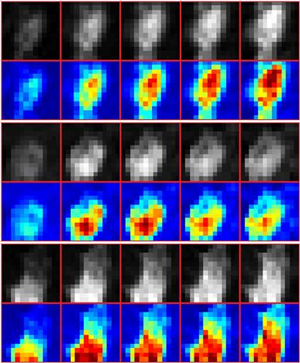
(TOP) Benign, (MIDDLE) malignant type I (washout)
and (BOTTOM) malignant type II (plateau) lesions,
as seen on 5 post-contrast images. Color images
help appreciate contrast uptake at each time point.
While the application of texture analysis to CADx tools for lesion classification on dynamic contrast-enhanced MRI (DCE-MRI) has been previously investigated, we specifically focus on texture features that can characterize the lesion enhancement pattern on small lesions, where characteristic properties are harder to detect.
We aim to improve the classification performance achieved with such lesions through features that offer a detailed characterization of the underlying gray-level topology and geometry of such contrast enhancing breast tissue lesions. We also quantify such features at different times following contrast injection, thereby also capturing dynamic behavior of lesion enhancement (see figure). The combination of morphological and dynamic properties can yield a large set of lesion characterizing features, not all of which are relevant to the task of classifying benign and malignant lesions. Thus, we also investigate the use of feature selection and dimension reduction techniques for computing efficient and compact representations of the extracted feature sets.
Journal Publications
- M.B. Nagarajan, M.B. Huber, T. Schlossbauer, G. Leinsinger, A. Krol, and A. Wismüller, "Classification of small lesions in dynamic breast MRI: Eliminating the need for precise lesion segmentation through spatio-temporal analysis of contrast enhancement," Machine Vision and Applications 24(7):1371-1381 (2013). PMID: 24244074
- M.B. Nagarajan, M.B. Huber, T. Schlossbauer, G. Leinsinger, A. Krol, and A. Wismüller, "Classification of small lesions on breast MRI: Evaluating the role of dynamically extracted texture features through feature selection," Journal of Medical and Biological Engineering 33(1):59-68 (2013). PMID:24223533
- M.B. Nagarajan, M.B. Huber, T. Schlossbauer, G. Leinsinger, A. Krol, and A. Wismüller, “Classification of small lesions on dynamic breast MRI: Integrating dimension reduction and out-of-sample extension into CADx methodology,” Artificial Intelligence in Medicine 60(1):65–77 (2014). PMID: 24355697
- T. Schlossbauer, G. Leinsinger, A. Wismüller, O. Lange, M. Scherr, A. Meyer-Bäse, and M.F. Reiser, "Classification of small contrast enhancing breast lesions in dynamic magnetic resonance imaging using a combination of morphological criteria and dynamic analysis based on unsupervised vector quantization," Investigative Radiology 43(1):56-64 (2008).
- A. Meyer-Bäse, A. Saalbach, O. Lange, and Axel Wismüller, "Unsupervised clustering of fMRI and MRI time series," Biomedical Signal Processing and Control 2:295–310 (2007).
- A. Wismüller, A. Meyer-Bäse, O. Lange, T. Schlossbauer, M. Kallergi, M.F. Reiser, and G. Leinsinger, "Segmentation and classification of dynamic breast MR image data," Journal of Electronic Imaging 15(1):013020 (2006).
- G. Leinsinger, T. Schlossbauer, M. Scherr, O. Lange, A. Meyer-Bäse, M.F. Reiser, and A. Wismüller, "Cluster analysis of signal-intensity time course in dynamic breast MRI: does unsupervised vector quantization help to evaluate small mammographic lesions?," European Radiology 16(5): 1138-1146 (2006).
- T.W. Nattkemper and A. Wismüller, "Tumor feature visualization with unsupervised learning," Medical Image Analysis 9(4):344-351 (2005).
- A. Wismüller, O. Lange, D.R. Dersch, G. Leinsinger, K. Hahn, B. Pütz, and D. Auer, "Cluster analysis of biomedical image time-series," International Journal of Computer Vision 46(2):103-128 (2002).